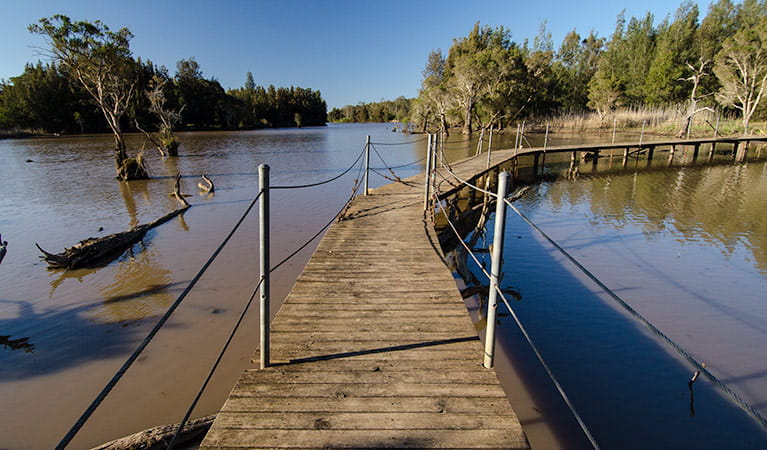Longneck Lagoon walking track
Scheyville National Park
Overview
A small freshwater wetland, Longneck Lagoon walking track allows visitors to see the startling array of birds that frequent the area. Perfect for walking with children.
- Distance
- 4km loop
- Time suggested
- 1hr 30min - 2hrs 30min
- Grade
- Grade 4
- Trip Intention Form
-
It's a good idea to let someone know where you're going. Fill in a trip intention form to send important details about your trip to your emergency contact.
- What to
bring - Drinking water, hat, sunscreen
- Please note
Remember to take your binoculars if you want to birdwatch
Longneck Lagoon walking track, a track which hugs banks of the small permanent freshwater wetland, has one very big attraction: birds. Over 140 species have been recorded at the park, with at least 42 species using the wetland on a regular basis (seven of which are protected by international treaty). Herons and egrets swoop overhead.
Surrounded by pleasant forest and offering a tranquil place perfect for walking with children, Longneck Lagoon walking track lets visitors engage with the area’s wildlife both safely and respectfully. Bring your camera and binoculars: as you walk beside the water, expect to see ducks, grebes, spoonbills and cormorants. There are plenty of good vantage points on this easy 4km walk. Don’t forget to keep an eye on the undergrowth too: some birds live down below in a thorn bush native to the area.
An education centre elaborates on the significance of Longneck Lagoon, but to extend your visit even further, head to the southern precinct of the park to explore Scheyville Camp precinct stop here for a picnic continue exploring along the Migrant Heritage walk.
Map
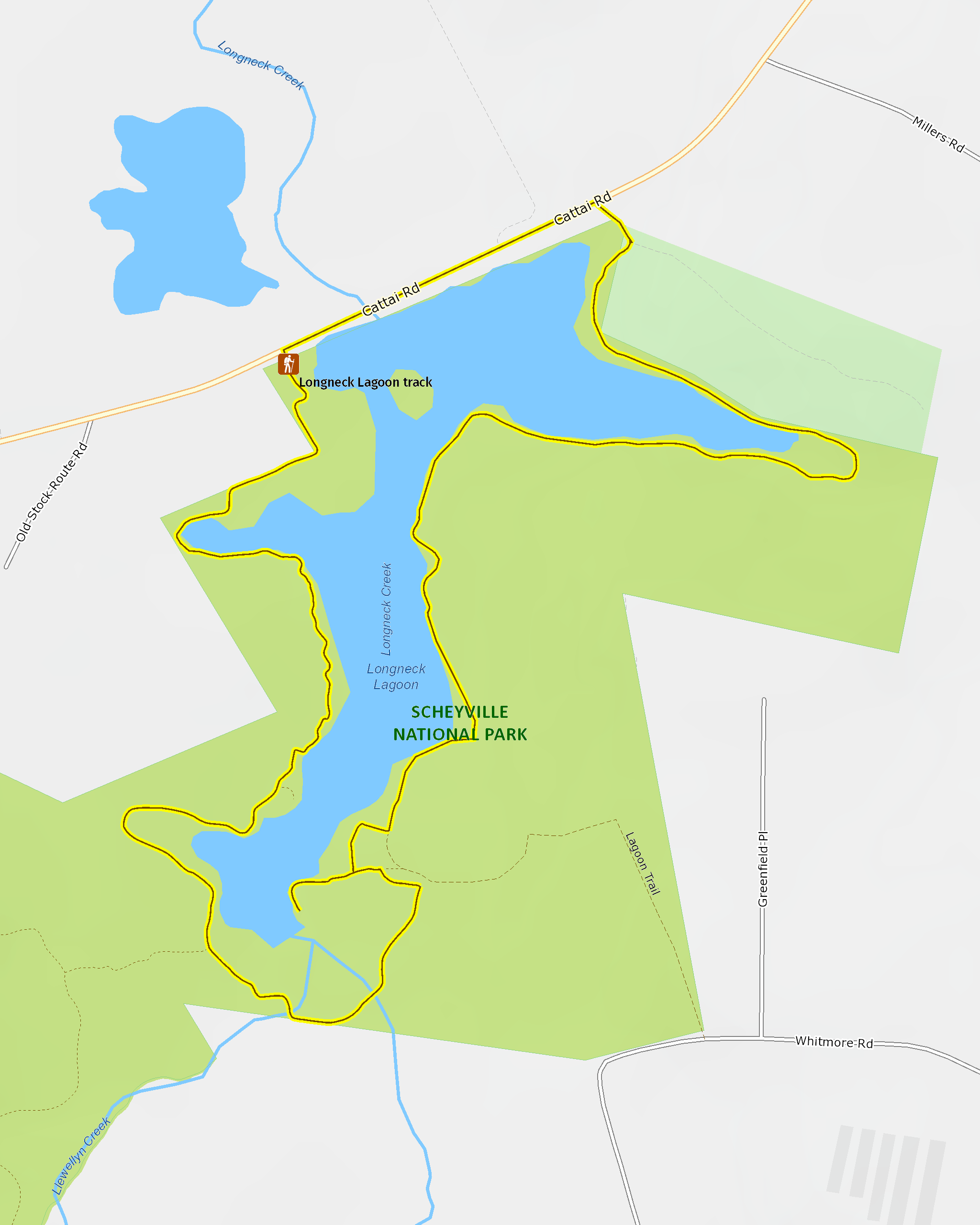
Map legend

Local alerts
For the latest updates on fires, closures and other alerts in this area, see https://www.nationalparks.nsw.gov.au/things-to-do/walking-tracks/longneck-lagoon-walking-track/local-alerts
General enquiries
- National Parks Contact Centre
- 7am to 7pm daily
- 1300 072 757 (13000 PARKS) for the cost of a local call within Australia excluding mobiles
- parks.info@environment.nsw.gov.au
Park info
- in Scheyville National Park in the Sydney and surrounds region
Scheyville National Park is open 8am to 6pm from May to August and 8am to 8pm from September to April. The park may have to close at times due to poor weather or fire danger.
Visitor info
All the practical information you need to know about Longneck Lagoon walking track.
Track grading
Features of this track
Distance
4km loop
Time
1hr 30min - 2hrs 30min
Quality of markings
Limited signage
Experience required
No experience required
Gradient
Flat
Steps
Occasional steps
Quality of path
Formed track, some obstacles
Getting there and parking
Longneck Lagoon walking track is in the northern precinct of Scheyville National Park. To get there:
- Drive 10km from Windsor along Cattai Road
- Longneck Lagoon is on the eastern side of the road near the bridge over Longneck Creek.
Parking
Parking is off Cattai Road, just before the bridge over Longneck Creek. Access to the walking track is via a sty over the boundary fence.
Best times to visit
There are lots of great things waiting for you in Scheyville National Park. Here are some of the highlights.
Autumn
Ride a horse around the central precinct of the park, where several trails thread over and around Longneck Creek.
Spring
Discover the area's fascinating heritage with a visit to the historical Scheyville Camp Precinct.
Summer
Take a morning stroll around Longneck Lagoon to observe the many bird species that call the wetland home, or drop in on their long migrations.
Weather, temperature and rainfall
Summer temperature
Average
11.2°C and 29.1°C
Highest recorded
42.5°C
Winter temperature
Average
4.1°C and 17.9°C
Lowest recorded
-7.2°C
Rainfall
Wettest month
January
Driest month
September
The area’s highest recorded rainfall in one day
309.4mm
Maps and downloads
Prohibited
Pets
Pets and domestic animals (other than certified assistance animals) are not permitted. Find out which regional parks allow dog walking and see the pets in parks policy for more information.
Smoking
NSW national parks are no smoking areas.
Learn more
Longneck Lagoon walking track is in Scheyville National Park. Here are just some of the reasons why this park is special:
Feathered migrants
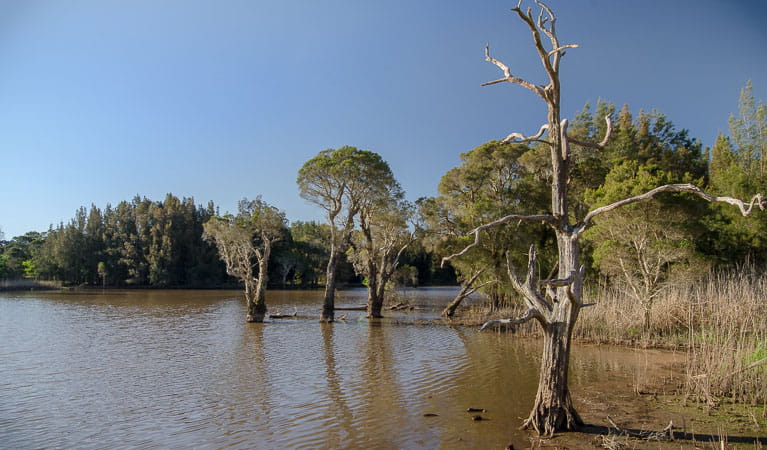
The park sustains an impressive population of permanent and migratory birds, including several precious species like the vulnerable swift parrot and turquoise parrot, and the endangered regent honeyeater. Bring some comfortable shoes and a pair of binoculars to get the most out of this quiet landscape, which changes throughout the year as different species come and go.
- Longneck Lagoon walking track A small freshwater wetland, Longneck Lagoon walking track allows visitors to see the startling array of birds that frequent the area. Perfect for walking with children.
Putting down roots
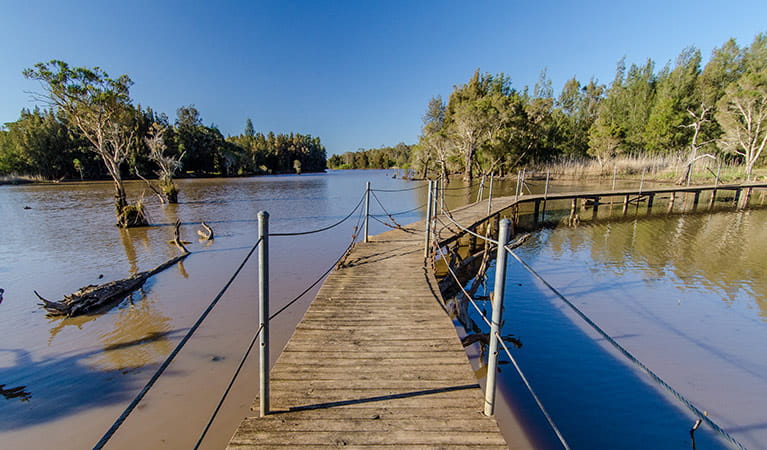
Scheyville National Park protects a large area of the Cumberland Plain Woodland, an endangered ecological community. There’s also a small area of Casltlereagh scribbly gum woodland and shale transition forest. Strolling through Scheyville has much to interest naturalists – and animal enthusiasts, for that matter. The native thorn bush is an important understory habitat for birds. There are over 140 types of waterbirds, offering superb birdwatching opportunities. There are horse riding tracks and places for cycling. There is even an education centre focusing on plants and animals.
- Longneck Lagoon walking track A small freshwater wetland, Longneck Lagoon walking track allows visitors to see the startling array of birds that frequent the area. Perfect for walking with children.
The Australian story
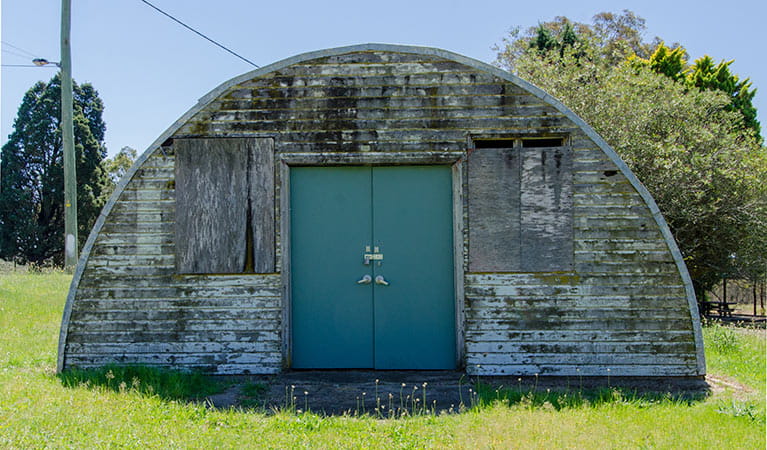
Scheyville has a rich heritage that gives us a great insight into the past 175 years of Australian history. It has played host to a government cooperative farm and an agricultural training facility. In World War I, it was an internment camp, in World War II, a training base for the First Australian Parachute Battalion. It’s also been a migrant camp for new Australians and an officer’s training unit in the Vietnam War. Scheyville has seen it all. And its remarkable life continues too: around a quarter of a million Australians are linked to the Scheyville site through their ancestors. Because of this, Scheyville is recognised by the NSW State Heritage Register.
- Migrant Heritage walk Migrant Heritage walk offers an easy stroll around original structures from the post-WWII migrant camp of Scheyville, with interpretive panels detailing the site’s heritage.
- Scheyville Camp precinct Take an easy walk around Scheyville Camp precinct in Scheyville National Park and explore the area's fascinating heritage. See restored buildings, remnants of structures long fallen, and uncover their unique history through interpretive signs.
Plants and animals protected in this park
Animals
-
Cumberland Plain land snail (Meridolum corneovirens)
The endangered Cumberland Plain land snail is only found on the Cumberland Plain, west of Sydney. During drought it digs deep into the soil to escape harsh conditions. Its brown shell is thin and fragile.

